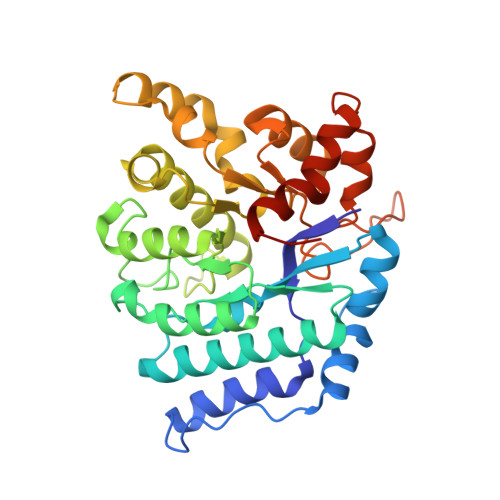The bacterialmeta-cleavage hydrolase LigY belongs to the amidohydrolase superfamily, not to the alpha / beta-hydrolase superfamily.
Kuatsjah, E., Chan, A.C.K., Kobylarz, M.J., Murphy, M.E.P., Eltis, L.D.(2017) J Biological Chem 292: 18290-18302
- PubMed: 28935670
- DOI: https://doi.org/10.1074/jbc.M117.797696
- Primary Citation of Related Structures:
5VN5 - PubMed Abstract:
Strain SYK-6 of the bacterium Sphingobium sp. catabolizes lignin-derived biphenyl via a meta -cleavage pathway. In this pathway, LigY is proposed to catalyze the hydrolysis of the meta -cleavage product (MCP) 4,11-dicarboxy-8-hydroxy-9-methoxy-2-hydroxy-6-oxo-6-phenyl-hexa-2,4-dienoate. Here, we validated this reaction by identifying 5-carboxyvanillate and 4-carboxy-2-hydroxypenta-2,4-dienoate as the products and determined the k cat and k cat / K m values as 9.3 ± 0.6 s -1 and 2.5 ± 0.2 × 10 7 m -1 s -1 , respectively. Sequence analyses and a 1.9 Å resolution crystal structure established that LigY belongs to the amidohydrolase superfamily, unlike previously characterized MCP hydrolases, which are serine-dependent enzymes of the α/β-hydrolase superfamily. The active-site architecture of LigY resembled that of α-amino-β-carboxymuconic-ϵ-semialdehyde decarboxylase, a class III amidohydrolase, with a single zinc ion coordinated by His-6, His-8, His-179, and Glu-282. Interestingly, we found that LigY lacks the acidic residue proposed to activate water for hydrolysis in other class III amidohydrolases. Moreover, substitution of His-223, a conserved residue proposed to activate water in other amidohydrolases, reduced the k cat to a much lesser extent than what has been reported for other amidohydrolases, suggesting that His-223 has a different role in LigY. Substitution of Arg-72, Tyr-190, Arg-234, or Glu-282 reduced LigY activity over 100-fold. On the basis of these results, we propose a catalytic mechanism involving substrate tautomerization, substrate-assisted activation of water for hydrolysis, and formation of a gem -diol intermediate. This last step diverges from what occurs in serine-dependent MCP hydrolases. This study provides insight into C-C-hydrolyzing enzymes and expands the known range of reactions catalyzed by the amidohydrolase superfamily.
- From the Genome Science and Technology Program and.
Organizational Affiliation:


















